Topics Covered
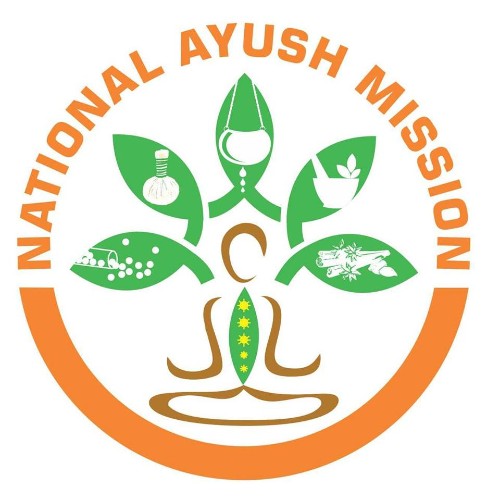
AYUSH
AYUSH represents a comprehensive approach to healthcare that encompasses ancient wisdom and holistic healthcare practices.
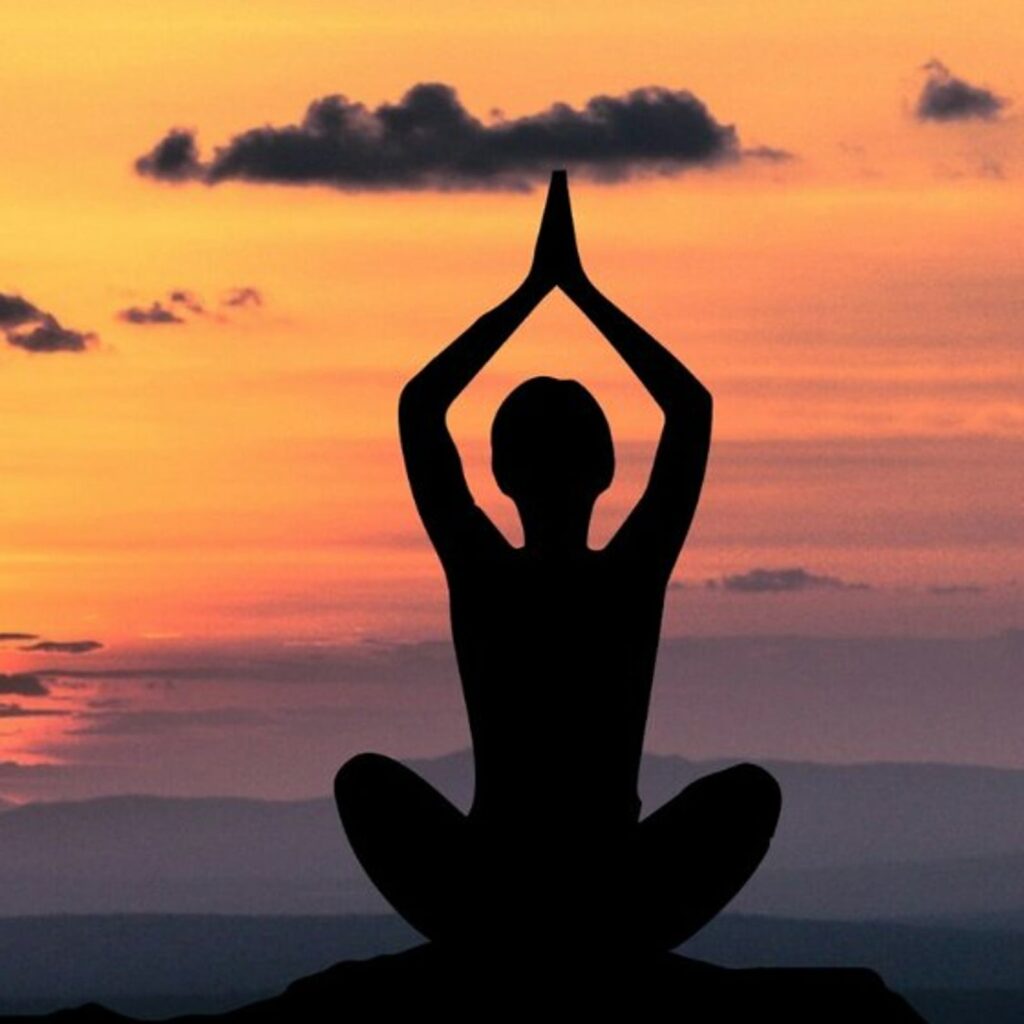
Yoga
By promoting the practice of Yoga, India can build bridges between different cultures and develop greater understanding for diversity.

Mission LiFE
An India-led global mass movement to nudge individual and community action to protect and preserve the environment.
AYUSH
The AYUSH systems, especially ‘Ayurveda’ are often referred to as the “Science of Life” which is deeply rooted in ancient Indian knowledge and has been practiced for millennia.
- While AYUSH has a strong foundation in traditional wisdom and experience, there has been an increasing interest in scientifically exploring its efficacy and safety through evidence-based studies.
R&D Initiatives of AYUSH Ministry
- 5 Research Councils as Autonomous institutes for undertaking research.
- Develop protocols and collaborate with national and international research organizations.
- AYUSH Ministry provides financial support for research projects through its Research Councils.
- Scheme of Extra Mural Research which encourages academic and research organizations to pursue research activities enriching scientific data and leading to scientific innovations having IPR Value.
- Interdisciplinary Research and development of Integrated Healthcare Models. For example, Centre for Integrative Medicine and Research (CIMR) was established within AIIMS-Delhi campus under AYUSH Centre of Excellence Programme, where proper scientific research on YOGA began for the first time in the country.
- The AYUSH Research Portal has been set-up for disseminating Evidence Based Research Data of AYUSH systems at Global Level.
- The AYUSH Ministry focuses on capacity building by organizing training programmes, workshops and conferences for researchers, stakeholders and clinicians.
- The research activities of AYUSH Councils includes medicinal plant research (Medico-ethno Botanical Survey, Pharmacognosy, and Tissue Culture), Drug Standardization Pharmacological Research, Clinical Research, Literary Research and Outreach Activities.
National Health Policy & AYUSH
- NHP, 2017 has strongly advocated mainstreaming the potential of AYUSH within the pluralistic system of Integrative Healthcare.
- Successful models of integrative medicine in National Healthcare Delivery and tertiary health set-ups includes NPCDCS, NRHM, NIMHANS, RCH, AIIMS, NCI Jhajjar etc.
WHO-GCTM
- WHO-Global Centre for Traditional Medicine is the first and only out posted center for traditional medicine across the globe, established in JAMNNAGAR.
- It strives to strengthen the scientific foundation of traditional medicine.
- It seeks to integrate traditional medicine in mainstream healthcare, ensure evidence-based practices, and enhance the overall quality and accessibility of traditional medicine services.
Research Model followed for AYUSH
- Exploring Traditional Knowledge : The Traditional Knowledge Digital Library (TKDL) is a pioneering initiative of India to protect Indian traditional medicinal knowledge and prevent its misappropriation at International Patent Offices.
- Integrated Modern Scientific Methods : For integration of AYUSH based interventions with modern medicine.
- Addressing Unmet Healthcare Needs : It focuses on fulfilling unmet healthcare needs, particularly in areas where modern medicine has limitations. For example, various CCRAS research initiatives have generated tangible evidence for Ayurveda and Yoga based interventions for mental health.
- Promoting lifestyle Modifications : By promoting preventive healthcare through lifestyle modifications and empowering individuals to take control of their well-being, AYUSH contributes towards tackling healthcare challenges in a holistic manner.
- Predictive, Preventive and Personalized Medicine : AYUSH’s holistic approach to health and well-being enables it to address multidimensional aspects of healthcare challenges. For example, AYURGENOMICS, also known as Ayurveda Genomics or genomic medicine in Ayurveda is an emerging field of research which is garnering significant interest.
UHC and SDGs
- The AYUSH system forms an important part of pluralistic foundation of healthcare in India based on the principle of Swasthyasya Swasthya Rakshanam.
- AYUSH is complying with the 4As of WHO’s strategic objective of UHC :Accessibility, Affordability, Availability and Acceptibility.
- AYUSH’s role in various SDGs :
- SDG 2(Zero Hunger) : Collaboration between AYUSH and WCD ministry for POSHAN Abhiyan.
- SDG 3(good health and well-being)
- SDG 10 (reduced inequalities) : through reduction in out-of-pocket expenditure.
- SDG 11 (sustainable cities and communities)
- SG 17 (global partnership for sustainable development)
AYUSH Stanardization
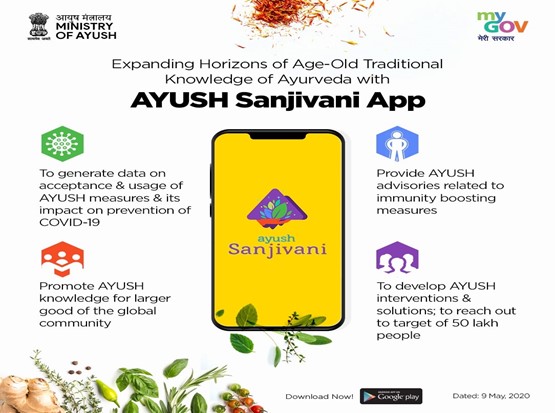
- During the Global AYUSH Investment and Innovation Summit 2022, the Prime Minister announced the launching of AYUSH MARK, which will give authenticity to quality Ayush products in the country.
- Ayush vertical at BIS will enable Ayush to develop standards and make stronger presence in ISO that will help in penetration in global markets.
- The integrative approach recognises the strengths of both traditional and modern systems, enabling a more holistic and patient-centered approach. to health. The emerging concept of ‘OneWorld “One Health’ emphasises the need for collaboration and coordination among various sectors and stakeholders to address global health challenges. The Covid has also highlighted the need for ‘One World One Health’ approach, which recognises the interconnectedness of human, animal, and environmental health. Ayush systems are rooted in traditional knowledge and practices that have been passed down through generations. This knowledge encompasses a deep understanding of the relationship between humans, animals, and the environment. Ayush can contribute its expertise to the ‘One World One Health’ approach by sharing traditional practices that promote harmony and balance in health and ecosystems.
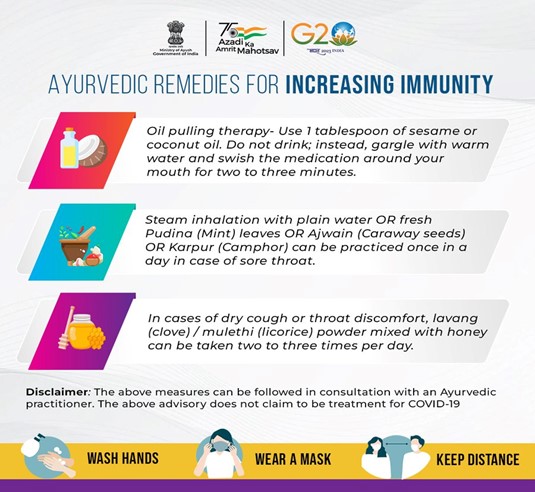
YOGA
Introduction
- By promoting the practice of Yoga, India can build bridges between different cultures and develop greater understanding and respect for diversity.
- This practice can help to promote physical and mental well-being, which is critical for individuals to thrive and contribute to the society.
- Moreover, Yoga can contribute towards global well-being by promoting peace and harmony, environmental sustainability, social harmony, cultural awareness, and unity in diversity.
- Studies have shown that Yoga can help in controlling Hormone Cortisol, which helps in reduction of stress and anxiety.
- The teachings of Yama and Niyama can help create the principles of AHIMSA and SANTOSHA, which are important not just for individual well-being, but also for social harmony.
- One of the fundamental principle of Yoga is “APARGRIHA” or non-possessiveness, which is an important principle for sustainable lifestyle and sustainable development.
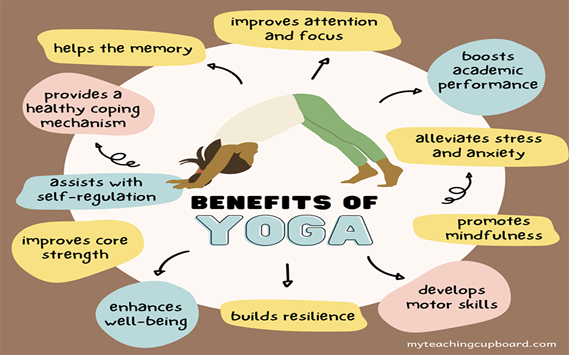
Yoga Practices for Health & Well-Being (HATH YOGA)
- Shatkarmas : Physical Purificatory practices in Hath Yoga.
- Yogasana : Psycho-physical postures for strength, flexibility, endurance and general fitness of body.
- Pranayama : Breath regulation. Traditionally, there are 8 different types of Pranayamas called the Ashta Kumbhakas.
- Mudra and Bandha : to channelize prana in body.
- Dhyana : Meditation
Research in Yoga
- Yoga’s prominence in Indian and Western civilization emerged in 20th century.
- Although a review of PubMed search using the keyword ‘yoga’ yields the earliest scientific studies dating back to 1964, there has been an exponential increase in publications since the beginning of 2000s.
- Extensive research has been done to evaluate the efficacy of Yoga on various diseases, especially Non-Communicable diseases.
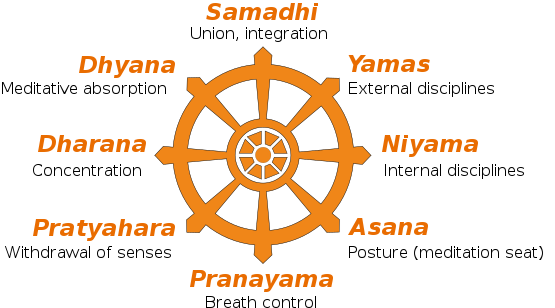
India’s Global Outreach with Yoga
- UN has recognized Yoga as a valuable tool for promoting health and well-being, and to celebrate its benefits International Day of Yoga is observed annually on 21st June.
- Yoga can help people and nations deal with global challenges as outlined in Sustainable Development Goals.
- The concept of Vasudhaiv Kutumbakam has been a part of Indian philosophy for centuries and is closely linked to the practice of Yoga. Yoga promotes oneness and unity, which is a relevant principle for current global scenario.
- India’s Presidency of G20 provides a platform to share India’s rich cultural heritage, including the practice of Yoga with the rest of the world.
Mission Life
Introduction
- Mission LiFE is an India-led global mass movement to nudge individual and community action to protect and preserve the environment.
- It was introduced in COP 26 of UNFCCC in Glasgow.
- India is the first country to include LiFE in its Nationally Determined Contributions.
Objectives
- Translate the vision of LiFE into measurable impact.
- Mobilize at least 1 billion Indians and other global citizens to individual and collective action for protecting and preserving the environment during 2022-27.
- At least 80% of all villages and urban local bodies are aimed to become environment-friendly by 2028.
- Nudge individuals and communities to practice a lifestyle that is synchronous. Those who practice such a lifestyle are recognized as “Pro Planet People”.
Building upon India’s Traditional Practices
- Adaptive architectural forms that minimize electricity consumption and hand-washing and sun-drying of clothes, as well as preference for plant-based foods can serve as the foundations for life.
- Unique water harvesting technologies, contextual to local traditions. For example – step wells of Gujarat & Rajasthan; Tankaa of Tamil Nadu; check dams(Johads) of Rajasthan; and Zabo system of Nagaland.
- Use of clayware for cooking and serving purposes. Several public food establishments continue to serve food in plant-based biodegradable utensils(sal tree leaves) and tea in clay pots(Kulhad).
Read more about Mission Life
Rest of the analysis will continue in the next post!
Official Website: https://www.publicationsdivision.nic.in/journals/index.php?route=page/yojana
Meditational Approaches Mental Well-Being

Introduction
- WHO’s Definition of Health: a state of complete well-being, not merely the absence disease or infirmity.
- Hippocrates’ Science of Medicine sets the goal of medicine as the complete removal of distress of the sick.
Something is Missing
- Despite the growth of modern healthcare at an accelerating pace, there are certain aspects to healthcare which are still unknown.
- Alternative and ancient systems of medicine (of Egypt, China and India) might reveal secrets unknown to modern medicine.
- Some ideas from Ayurveda, Naturopathy and Yoga are still mind-boggling for even modern researchers.
Healing & Holistic Well-Being
- Holistic well-being can be ensured only by therapies or processes that ensure the health of the whole being, comprising the body, mind and soul.
- Healing is what restores health. Healing is not just restricted to boy, but includes mind and emotions as well.
- This is reflected in a well-known Latin saying, Mens sana in corpore sano.
Heart’s Foundational Intelligence in Healing
- Paul Pearsall’s “The Heart’s Code” reveals the relationship between the ‘emotional heart’ & ‘psychological heart’ and the actual physical heart.
- The foundation of our good health is the sustenance of a life force or our stating alive.
- Therefore, nourishment of the soul is therefore essential for a healthy life.
Koshas in Healing
- The Upanishads describe the Koshas as the five layers of awareness, starting with the physical body and moving deeper, inward, to the deepest layer of our soul or innermost self.
- The practice of Yoga and Meditation helps us experience these layers and brings us closer to understanding them.
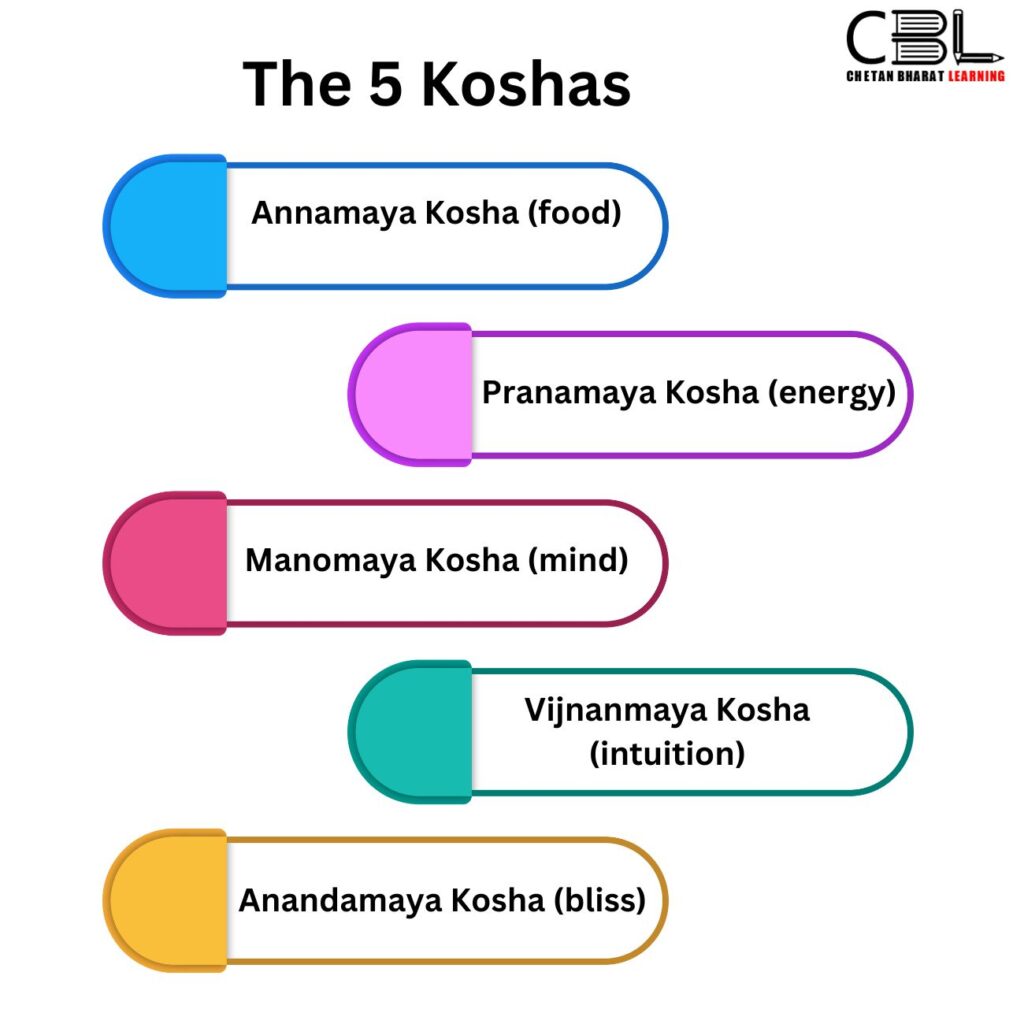
Vaccine for Mental & Emotional Health
Meditation acts as a vaccine for mental and emotional health. It aids in reduction of daily levels of stress and tension.
Most modern diseases are Psychosomatic in nature and hence it won’t be wrong if one establishes a connection between mental health and various lifestyle diseases.
Cascading effects of meditation:
- Reduction in digital addiction;
- Healthy sleep patterns due to less screen exposure;
- Well-regulated circadian rhythm and improved physiological processes.
OTHER BENEFITS
DHYANA MUDRA

- Improved serotonin
- melatonin levels
JNANA MUDRA

- Good telomere length
- Other health indicators that are yet to be discovered.
- Meditational approaches are known to thus create significant improvements in mental health and well -being and emotional resilience. We become more and more aware of our actions and even our life purpose. There is, of course, significant research and evidence in how it reduces anxiety, calms us, gives us peace, and even works on the very root of all problems. But let me tell you the secret that I have reserved for last. Meditation is not merely a means for good health. Meditation is not merely a means for good health. Meditation lets us experience an eternal good life in every moment of our existence. And this beautiful duet between meditational approaches and well being is not merely about physical, mental, and emotional well being, it lets us rendezvous with life in its most exuberant manner, in joy, health and heart.
Non-Possession: A Gandhian Thought
- A happy working of the machine depends upon the harmonious activity of the various component parts.
- Gandhi Ji’s sustainable and minimalist lifestyle was based on self-discipline.
- Possession implies provision for the future.
- If each retained possession only of what he needed, non-one would be in want, and all would live in contentment.
Gandhi JI’s 11 Vows
- These 11 vows were mentioned by Gandhi Ji in his weekly letters to his Ashramites from Yerwada Central Prison (1930).
- Just as non-violence can only be observed a strong person, not by a coward, vows are a sign of strength, not weakness.
- He arrived at each vow by experimenting it on himself. Hence the name of his autobiography “My Experiments with Truth”.
Significant Events of Gandhi Ji’s Life
- Went to England in 1888 to become a barrister and registered himself with the British Bar.
- Came back to India to practice as a barrister in Bombay High Court.
- Went to South Africa to help a Gujarati Businessman Seth Abdullah.
- Founded Natal Indian Congress on 22 August 1894 to fight against color prejudice.
- Returned to India in 1901.
- Returned back to South Africa in November 1902.
- In October 1904, he took the responsibility of Indian Opinion, a weekly newspaper published in English, Hindi, Gujarati and Tamil.
- Established Phoenix Ashram/Settlement in 1904.
1928 Rules for Ashram & Ashramites
- All ashramites should attend the morning prayer at 4:00 AM.
- All should eat at the community kitchen.
- Should spin 160 threads on a daily basis.
- No servant or labour should be hired for house work.
- All adult men should engage themselves in night vigilance.
- All young and adults should take turns in cleaning toilets.
- Each person living in the ashram should do the work for the ashram at least for 8 hours daily.
- One should maintain a daily diary and note all the work done during the day.
Indigenous Heavyweight Torpedo Varunastra
- Created by the Naval Science and Technological Laboratory (NSTL) under the Defence Research and Development Organisation (DRDO), and manufactured by Bharat Dynamics Ltd (BDL),
- Varunastra combines advanced features such as low drift navigational systems, acoustic homing, and autonomous guidance algorithms.
- A maximum speed of 40 knots and a maximum operating depth of 600 meters.
- It boasts long-range capabilities with multi-maneuvering features, making it highly effective in tracking and targeting silent underwater threats
Tobacco Cultivation and Food Insecurity
- The World Health Organization (WHO) has released a new report highlighting the urgent need to prioritize food production over tobacco cultivation.
- The report emphasizes that approximately 349 million people worldwide are currently facing acute food insecurity, while valuable fertile land is being occupied by tobacco farming. The tobacco industry’s interference in efforts to substitute its crops exacerbates the global food crisis.
- Also, World No Tobacco Day, observed annually on May 31 serves as a reminder of the ongoing battle against global tobacco epidemic. The theme of 2023 is “Grow food, not tobacco”.
How is the Global Food Crisis Related to Tobacco Farming?
- Land Use Competition: Both food production and tobacco farming require land resources.
- Resource Diversion: Tobacco farming requires significant amounts of resources, including water, fertilisers, and labour.
- Financial Impact: Tobacco farming can be financially lucrative for farmers, leading them to prioritise tobacco cultivation over food crops.
- Environmental Impact: Tobacco farming practices can have adverse environmental effects.
- Deforestation, soil degradation, and water pollution are often associated with tobacco cultivation. These environmental impacts can further strain the availability of natural resources needed for sustainable food production.
- Health Consequences: Tobacco use is a major public health concern, leading to numerous diseases and premature deaths worldwide.
What is the Status of Tobacco Consumption in India
- India is also the second largest consumer and producer of tobacco after China
- Tobacco use is known to be a major risk factor for several non-communicable diseases such as cancer, cardiovascular disease, diabetes, and chronic lung diseases. Nearly 27% of all cancers in India are due to tobacco usage.
Indian Initiatives to Curb Tobacco Consumption
- The Promulgation of the Prohibition of Electronic Cigarettes Ordinance, 2019 prohibits Production, Manufacture, Import, Export, Transport, Sale, Distribution, Storage and Advertisement of e-Cigarettes.
- The Government of India launched the National Tobacco Quitline Services (NTQLS) which have the sole objective to provide telephone-based information, advice, support, and referrals for tobacco cessation.
- The Union Finance Minister of India announced a 16% increase in National Calamity Contingent Duty (NCCD) on cigarettes in the Budget 2023-24.
- The Union Health Ministry of India has announced new regulations requiring Over-The-Top (OTT) platforms to display tobacco-related health warnings during streamed content.
Evergreening of Loans
- Evergreening loans, a form of zombie lending, is a practice of extending new or additional loans to a borrower who is unable to repay the existing loans, thereby concealing the true status of the non-performing assets (NPAs) or bad loans
- Evergreening loans can create a false impression of the asset quality and profitability of banks and delay the recognition and resolution of stressed assets.
- It can also undermine the credit discipline and moral hazard among borrowers, and erode the trust and confidence of depositors, investors and regulators.
What is a Non-Performing Asset
- NPA refers to a classification for loans or advances that are in default or are in arrears on scheduled payments of principal or interest.
- Banks are required to classify non-performing assets further into the following three categories based on the period for which the asset has remained non-performing and the realizability of the dues:
- Sub-standard Assets: A substandard asset is an asset classified as an NPA for a period less than or equal to 12 months
- Doubtful Assets: A doubtful asset is an asset that has been nonperforming for a period exceeding 12 months.
- Loss Assets: Assets that are uncollectible and where there is little, or no hope of recovery and that needs to be fully written off.
Loan write-off Vs. Evergreening:
- Loan write-offs are a process of removing bad loans from the books of banks after making adequate provisions for them. Loan write-offs do not mean that the borrowers are relieved of their repayment obligations or that the banks stop pursuing recovery from them. Loan write-offs are done to clean up the balance sheet of banks and reflect their true financial position.
- Evergreening of loans, on the other hand, is a practice of extending new or additional loans to a borrower who is unable to repay the existing loans, thereby concealing the true status of the non-performing assets (NPAs) or bad loans.
Hunger Hotspots: FAO-WFP
- According to a recent Report by Food and Agriculture Organization (FAO) and World Food Program (WFP) Hunger Hotspots – FAO-WFP early warnings on acute food insecurity, India’s neighbors, Pakistan, Afghanistan and Myanmar, are among the hunger hotspots in the world
What are the Highlights of the Report
- Hot Spots with Very High Concern:
- There are 18 areas in 22 countries where acute Food Insecurity may increase in magnitude and severity.
- Pakistan, the Central African Republic, Ethiopia, Kenya, the Democratic Republic of the Congo and the Syrian Arab Republic are hotspots with very high concern.
- Countries at Highest Concern Level:
- Afghanistan, Nigeria, Somalia, South Sudan and Yemen remain at the highest concern level.
- Haiti, the Sahel (Burkina Faso and Mali) and the Sudan have been elevated to the highest concern levels; this is due to severe movement restrictions of people and goods in Haiti, as well as in Burkina Faso and Mali, and the recent eruption of Conflict in Sudan.
- Expected to Face Starvation:
- All the hotspots at the highest level have populations facing or projected to face starvation, or are at risk of deterioration towards catastrophic conditions, given they already have critical food insecurity and are facing severe aggravating factors.
- New Emerging Conflicts:
- New emerging conflicts, in particular the eruption of conflict in the Sudan, will likely drive global conflict trends and impact several neighboring countries.
- Weather Extremes:
- Weather extremes, such as heavy rains, tropical storms, Cyclones, Flooding, Drought and increased climate variability, remain significant drivers in some countries and regions.
- The May 2023 forecast suggests an 82 % likelihood of El Niño conditions starting in the May–July 2023 period, with significant implications for several hunger hotspots.
- Economic Shocks:
- Deepening economic shocks continue to drive low- and middle-income nations deeper into crisis.
Food and Agriculture Organization
- FAO is a specialized agency of the United Nations that leads international efforts to defeat hunger.
- World Food Day is celebrated every year around the world on 16th October. The day is celebrated to mark the anniversary of the founding of the FAO in 1945.
- It is one of the UN food aid organizations based in Rome (Italy). Its sister bodies are the World Food Programme and the International Fund for Agricultural Development (IFAD).
World Food Programme
- The WFP is the leading humanitarian organization saving lives and changing lives, delivering food assistance in emergencies and working with communities to improve nutrition and build resilience.
- It was founded in 1961 by the FAO and United Nations General Assembly (UNGA) with its headquarters in Rome, Italy.
- It is also a member of the United Nations Sustainable Development Group (UNSDG), a coalition of UN agencies and organizations aimed at fulfilling the Sustainable Development Goals (SDGs).
- The international community has committed to end hunger, achieve food security and improve nutrition by 2030.
Direct-Seeding Method
- Direct Seeded Rice (DSR), also known as the ‘broadcasting seed technique,’ is a water-saving method of sowing paddy.
- In this method, seeds are directly drilled into the fields, eliminating the need for nursery preparation and transplantation.
Benefits:
- Reduction in Labor:
- With the use of drum seeders, only two laborers are required to sow seeds on one acre, compared to 25-30 laborers needed in traditional methods.
- This significantly reduces labor costs and eases the burden on farmers.
- Time and Resource Savings:
- By eliminating the need for nursery cultivation, farmers save approximately 30 days in the crop cycle.
- This allows them to start the rabi season early and avoid untimely rains during the harvesting phase.
- Water Conservation:
- Increase in Yield:
- According to the results from research trials and farmers’ field survey, after this technique the yield is one to two quintals per acre higher than puddled transplanted rice.
- Weed Growth:
- Weed growth becomes a challenge as seeds are sown directly into the fields.
- Extreme climate:
- High temperatures and deficient rainfall can affect seed germination and crop growth.
- Operational challenges:
- Closed canals, erratic electricity supply, and issues with weed control and pest management.
Mekedatu Project
- The Karnataka Assembly has unanimously adopted a resolution requesting clearance for the Mekedatu drinking water and balancing reservoir project.
- This resolution was in response to Tamil Nadu’s opposition to the project.
- The Mekedatu project is a multipurpose project involving the construction of a balancing reservoir near Kanakapura in Ramanagara district, Karnataka.

- Mekedatu, meaning goat’s leap, is a deep gorge situated at the confluence of the rivers Cauvery and its tributary Arkavathi.
- Its primary objectives are to provide drinking water to Bengaluru and neighboring areas, totaling 4.75 TMC, and generate 400 MW of power.
Benefits of the Project:
- Meeting the growing demand for drinking water in Bengaluru and its adjoining areas facing water scarcity and dependence on groundwater.
- Harnessing renewable energy by generating 400 MW of hydroelectric power.
- Contributing to renewable energy production and reducing carbon emissions.
- Regulating the flow of water to prevent floods and droughts, benefiting farmers and communities.
Opposition By Tamil Nadu:
- Tamil Nadu argues that the Mekadatu dam would significantly reduce the water flow downstream, negatively impacting the state’s agricultural activities and water supply.
- The Cauvery River is a crucial water source for Tamil Nadu, supporting its farming communities and meeting the drinking water needs of its residents.
- The state claims that the project violates the final judgment of the Cauvery Water Disputes Tribunal (CWDT), which allocated a specific share of water to each riparian state, including Tamil Nadu.
River Cauvery (Kaveri)
- It is known as ‘Ponni’ in Tamil, and it is the fourth largest river in southern India.
- It is a sacred river of southern India. It rises on Brahmagiri Hill of the Western Ghats in southwestern Karnataka state, flows in a southeasterly direction through the states of Karnataka and Tamil Nadu, and descends the Eastern Ghats in a series of great falls and drains into Bay of Bengal through Pondicherry.
The Dispute:
- The genesis of the dispute is 150 years old and dates back to the two agreements of arbitration in 1892 and 1924 between the then Madras presidency and Mysore
- It entailed the principle that the upper riparian state must obtain consent of lower riparian state for any construction activity viz. reservoir on the river Cauvery.
- The Cauvery water dispute between Karnataka and Tamil Nadu began in 1974 when Karnataka started diverting water without Tamil Nadu’s consent.
Kavach
- Kavach is an indigenously developed Automatic Train Protection (ATP) system aimed at enhancing safety in train operations across the vast network of Indian Railways.
- Developed by the Research Design and Standards Organization (RDSO) in association with three Indian vendors, it has been adopted as our National Automatic Train Protection (ATP) System.
- The Indian Railways Institute of Signal Engineering & Telecommunications (IRISET) in Secunderabad, Telangana hosts the ‘Centre of Excellence’ for Kavach.
- IRISET is responsible for training in-service railway staff on Kavach through its dedicated Kavach lab.
- The system meets Safety Integrity Level-4 (SIL-4) standards, signifying its high reliability.
- Prevents trains from passing red signals and enforces speed restrictions.
- Activates the braking system automatically if the driver fails to control the train.
- Prevents collisions between two locomotives equipped with Kavach systems.
- Relays SoS messages during emergency situations.
- Offers centralised live monitoring of train movements through the Network Monitor System.
- Utilises Traffic Collision Avoidance System (TCAS) for two-way communication between the station master and loco-pilot.
Himalayan Brown Bear
IUCN Status: Critically Endangered
CITES: Appendix I
Wildlife Protection Act: Schedule 1

- Population in Kashmir is facing numerous challenges that threaten both their survival and human safety
- Himalayan brown bears are a subspecies of brown bears that inhabit the high-altitude regions of the Himalayas, ranging from Pakistan to Bhutan.
- They have thick fur that is most often sandy or reddish-brown in color.
Status:
- IUCN Red List- Critically Endangered
- Brown bear (Ursus arctos) is listed as Least Concern.
CITES – Appendix I.
- Only the populations of Bhutan, China, Mexico and Mongolia; all other populations are included in Appendix II.
- Indian Wildlife (Protection) Act of 1972 – Schedule 1.
Range:
- North-western and central Himalaya, including India, Pakistan, Nepal, the Tibetan Autonomous Region of China, and Bhutan.
PM SVANidhi Scheme
- It is a Central Sector Scheme i.e., fully funded by Ministry of Housing and Urban Affairs with the following objectives:
- To facilitate working capital loan;
- To incentivize regular repayment; and
- To reward digital transactions
- Introduction of 3rd term loan of up to ₹50,000 in addition to 1st & 2nd loans of ₹10,000 and ₹20,000 respectively.
- The loans would be without collateral.
Lending Agencies:
- Microfinance Institutions, Non-Banking Financial Company, Self Help Groups have been allowed due to their ground level presence and proximity to the urban poor including the street vendors.
Eligibility:
- States/Union Territories (UTs):
- The Scheme is available for beneficiaries belonging to only those States/UTs which have notified Rules and Scheme under Street Vendors (Protection of Livelihood and Regulation of Street Vending) Act, 2014.
- Beneficiaries from Meghalaya, which has its own State Street Vendors Act may, however, participate.
Street Vendors:
- The Scheme is available to all street vendors engaged in vending in urban areas.
- Earlier the Scheme was available to all street vendors engaged in vending on or before March 24, 2020.
Benefits of Early Repayment:
- Interest Subsidy
- Credit Limits Extension
- No-Penalty on Early Repayment:
- E-governance:
- Financial Inclusion:
- Focus on Capacity Building:
Prepaid Payment Instrument
- PPIs are instruments that facilitate the purchase of goods and services, conduct of financial services and enable Remittance facilities, among others, against the money stored in them.
- PPIs can be issued as cards or wallets.
Issuance:
- DICGC is a wholly owned subsidiary of the RBI and provides deposit insurance.
- The deposit insurance system plays an important role in maintaining the stability of the financial system, particularly by assuring the small depositors of the protection of their deposits in the event of a bank failure.
- The deposit insurance extended by DICGC covers all commercial banks including Local Area Banks (LABs), Payments Banks (PBs), Small Finance Banks (SFBs), Regional Rural Banks (RRBs) and co-operative banks, that are licensed by the RBI.
